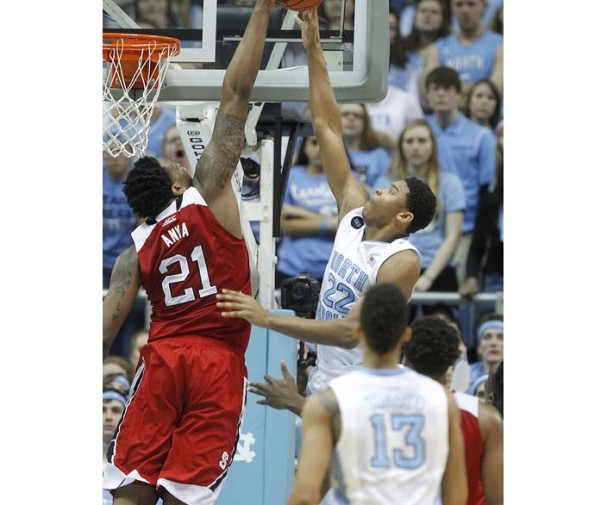Note – The great pic from the WRAL or N&O doesn’t really tie into the article. I just like it.
I really appreciate the Wolfpack extending the basketball season so that the latest OOC SOS summary will appear before we move into baseball and the long drought until football comes back on Labor Day weekend. I haven’t done one of these entries in several years, so it seemed like a good time to get up the companion piece to the ACC SOS entry.
Looking at several teams’ schedules, the OOC schedule seems to be about a baker’s dozen…so a little over 40% of the regular season schedule. The key point that I want to make once again is that while most people (at least in my house) tend the view the OOC schedule as the pre-season, the results can have a significant effect on Selection Sunday over three months after the OOC schedule has concluded.
In the days of Herb and Sid, I used to bemoan the fact that our coaches obviously missed the importance of making strategic decisions when building the OOC schedule. I’m very grateful that this particular problem completely disappeared with Gottfried’s arrival in Raleigh. So let’s first update the summary table that I’ve used over the years and modified as the conference grew:
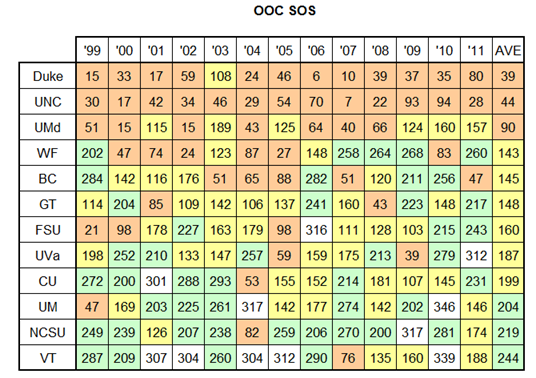
The info in the first versions of this table came from Ken Pomeroy’s site and then I had to find other sources after he became enamored with his own analysis system. The 2011 data came from ESPN and the other years were from wherever I managed to find the info. For completeness I wish that I had noted where the info came from, but you can’t have everything.
I first put this summary table together to dispute the HSSS’s claims that State’s poor OOC schedule was a result of “bad luck” (since nothing was every Herb’s fault). I think that this table proves that if you want a good OOC schedule, you can pick your definition of “good” and then pick your schedule. The consistency at the top and bottom makes it impossible to support any other conclusion.
I can’t imagine that I’ll have any need for this old table again, but it was worth updating just to illustrate how much things have changed over the last four years. You can imagine how happy I was to hear in the early Gottfried interviews that he had to redo the OOC schedule for his first year as coach. So here’s the updated table prepared by pretending that the latest version of the ACC was actually in place for the last four years:
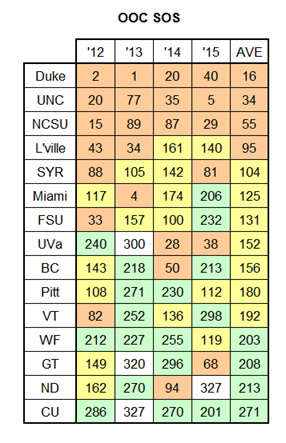
Random Thoughts:
Oliver Purnell managed to upgrade Clemson’s OOC schedule for a little while (tenure from ’03-’10). But it didn’t take very long after his unexpected departure for Clemson to return to their historical roots.
2013 is an especially good year for me because UVA manages to absolutely destroy some nonsense that gets spouted from time-to-time. They were 21-10 (11-7) heading into the ACCT…and landed straight into the NIT (after losing to State in the first round). If their season doesn’t kill the 20-win nonsense forever, then it is simply more evidence to support Ron White (You Can’t Fix Stupid). A horribly weak OOC schedule undoubtedly helped determine their post-season tournament that year.
WF has taken a nose-dive in more ways than one since Skip Prosser’s untimely death in 2007. Hopefully, Manning can improve the team as well as he did their OOC schedule this year.
You have to wonder what happened to Larranaga this year.
The only time that I can justify a super-weak OOC schedule is in a rebuilding year where you are just hoping to make the NIT. So I won’t make any comparisons between Buzz and Greenburg…but he better upgrade VT’s schedule quickly or the comparisons will come.
Please share anything that stands out to you in the comments.
Earlier this year, I noticed that the OOC SOS can change greatly from our first look (normally at the first of Jan) and the end of the ACCT. So here’s the summary of where the SOS started and where it ended up:
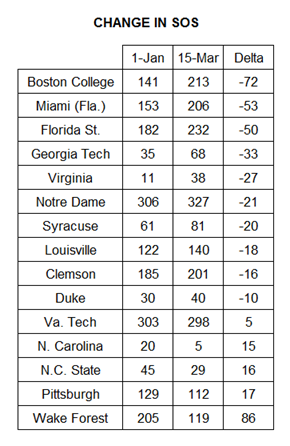
It’s interesting that both of the last two years, 2/3 of the conference saw their OOC SOS drop. This general trend makes sense to me since most of the OOC schedule is made up of mid/lower major teams and these teams generally drop down through the RPI as their overall SOS decreases. But in contrast to the general trend, State’s OOC SOS has improved both years. If this trend continues, I’ll have to muster up enough energy to investigate.
The other general trend is that for most teams, the change isn’t really all that significant this year. But at the far extremes, the differences are surprising (at least to me).
The following graph illustrates the changes seen over the last two years:
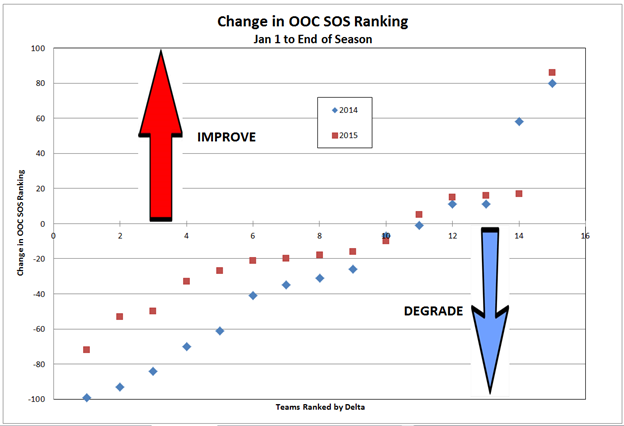
I don’t think that there was any team this year that scheduled their way into the NIT like SMU did last year…and Seth Greenburg did several times at VT. But the best example that I have to illustrate the punitive nature of the NCAAT Selection process over the issue of OOC scheduling is Penn St. in 2009. From the post-mortem that year, here was my bottom line:
Let’s…list the various stats for the [last] six teams that got in along with Penn St and see what we can find.
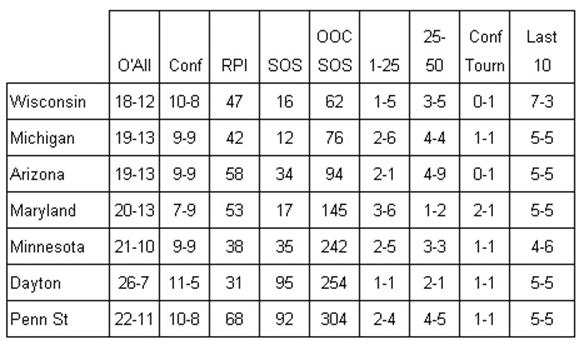
Here are some arguments for including Penn St in the NCAAT.
– They tied for the most wins against the top-50 (6).
– Only one team had more wins against the top-25.
– Two teams included in the NCAAT lost in the first round of their conference tournament (including one from the Big 10).
– Two teams from the Big 10 that were selected (Minn and Mich) had worse conference records and all three had the same results in the conference tournament (1-1).
So why was Penn State left out?
Personally, I believe that the Selection Committee made a conscious decision to penalize Penn St for their OOC schedule. I go back to my old formula which has worked against a number of ACC teams in the past and got Arizona State last year:
Miserable OOC schedule +
Mediocre conference performance +
Mediocre conference tourney performance =
NIT
Never forget, the OOC schedule is a choice. There is plenty of evidence to support the conclusion that the Selection Committee penalizes marginal teams when they make a bad choice. For ACC teams, this is an important lesson to learn because the large variation in conference SOS means that you could end up with a weak conference schedule through no fault of your own. For a team as good as ND this year, it wasn’t a problem. But you don’t want to be on the bubble with a weak overall schedule on your resume.


